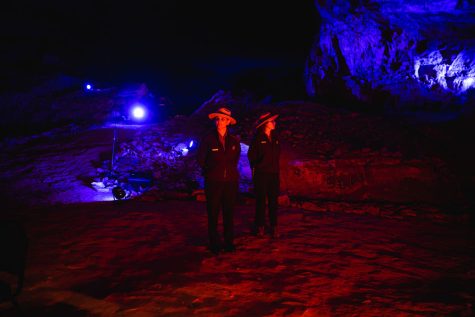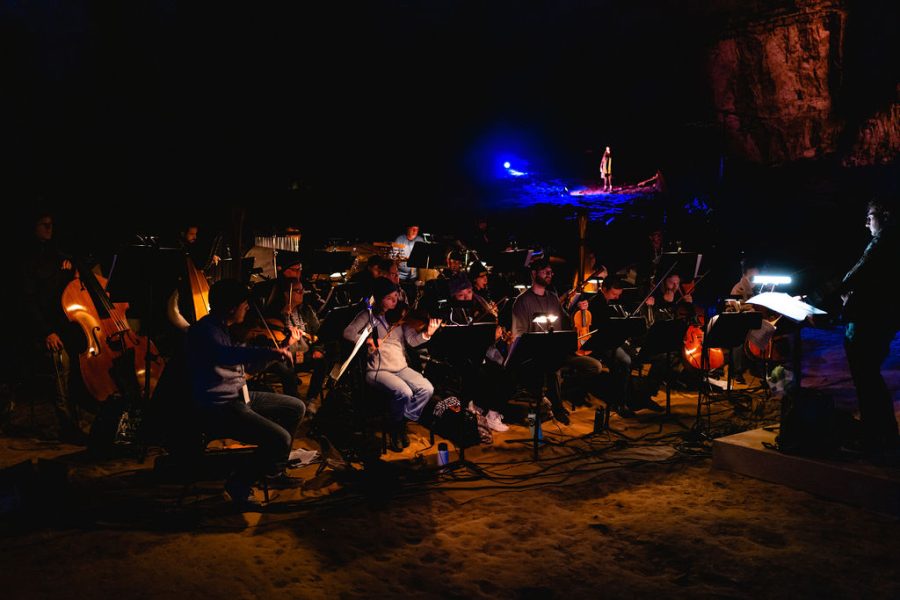‘It’s not a concert at all, it’s truly an experience’: Yo-Yo Ma and Louisville Orchestra perform at Mammoth Cave
May 1, 2023
A sign flashing “No public cave tours today” and “Special event” is posted by the road leading to the Mammoth Cave Visitor Center as hundreds of people eagerly gather to await a performance by the Louisville Orchestra, the Louisville Chamber Choir and world renowned cellist Yo-Yo Ma on April 29.
Out of more than 32,000 applicants, both from within the United States as well as internationally, roughly 1,000 people were winners of the online ticket lottery conducted by the park service.
Approximately 500 people wait to go into Rafinesque Hall, an open space nearly half a mile inside the cave, to hear Teddy Abrams, the musical director and composer with the Louisville orchestra, Yo-Yo Ma and many others perform a musical and theatrical piece.
Abrams composed the piece “Mammoth” specifically for the cave after going to the cave and taking every tour offered, he said.
“This is not the place where you just go play a piece of music you like from the past,” Abrams said. “First and foremost let the cave tell its story through this performance.”
According to Abrams, “Mammoth” is broken up into roughly three parts that all come together to tell the story of the cave. The piece begins with the natural history of the cave’s forming before moving into the human history and ending with the “spirituality of the cave.”
The performance featured 15 instruments, including water tanks and harps, trombones, flutes, cellos and various percussion instruments, as well as members from the Louisville Chamber Choir who sang along with the musical performance.
“This event is really celebrating Mammoth Cave,” Molly Schroer, public information officer for Mammoth Cave, said. “They are putting together a performance that is all centered around the cave. They have immersed themselves […] as much as they can.”
After the roughly two hour performance, the crowd lining the edges of the hall gave a rousing round of applause as Abrams, Yo-Yo Ma and all the performers took their bows.
Henry Royse, mayor of Glasgow, said he was awestruck by the display of talent.
“The creativity in this room is amazing,” Royse said. “I was taken aback.”
Abrams said this idea began as a joke between him and Yo-Yo Ma on a podcast but slowly started becoming a reality as Ma was working on “Our Common Nature,” a “celebration of the ways nature can reinvigorate the human experiment, reuniting us in pursuit of a common future,” and was eager to perform in Mammoth Cave.
“At first it was kind of a joke like ‘we should take the whole orchestra to Mammoth Cave,’” Abrams said. “Then we started saying ‘wait, maybe we should take the whole orchestra to Mammoth Cave’ and the idea kept growing and growing and growing.”
Composing the music was very time intensive, Abrams said, requiring many months of research and many days and weeks of sleepless nights.
“The research alone was a good seven to eight months of work,” Abrams said. “Then the actual composition I started in November and for six weeks I did that anywhere from 10 to 20 hours a day. There were many days I just didn’t sleep.”
Abrams said he is overwhelmed to hear his music played by such notable people and is happy to now be forever a part of the cave’s over 5,000 year long story.
“If you’re not completely overwhelmed with awe and appreciation and understanding of how beautiful that is I wouldn’t know what to say,” Abrams said. “It’s human to recognize that.”
This event would not have been possible, Abrams said, without the cooperation of Mammoth Cave National Park, who accepted Abrams request to perform in the cave last year without knowing the famous cellist would be coming, Schroer said.
Once they knew Abrams would be performing in the cave, Schroer said, the team at Mammoth Cave assembled to determine if there were issues with the cave or with the wildlife within.
“Looking at the resource protection, making sure none of these activities are going to harm the cave or overly impact our visitor services throughout this week has been a top priority for us.”
Schroer said music is not unusual in the cave. Mammoth Cave hosts the annual “Cave Sing” and tour guides used to sing while giving tours.
“It’s a musical experience, but nothing quite on this scale,” Schror added.
“Music in the cave has happened for hundreds of years,” Schoer said. “The cave is just a great spot for sounds. You go down there and you want to sing […] so it’s the perfect spot for this type of activity.”
With everything this size comes all sorts of logistics and unique challenges. This production was no exception.
The orchestra began moving their instruments into the cave Sunday night, Schroer said.
To accommodate for the cave’s cooler temperatures and higher humidity, Abrams said a lot of the stringed instruments were replaced with carbon fiber ones, including Yo-Yo Ma’s Cello.
“This falls into the category of the million details we’ve had to deal with,” Abrams said. “What we’ve done is found secondary instruments, some of them are carbon fiber, for the musicians to play. [Yo-Yo Ma] is playing with carbon fiber, it’s not the best idea to take $25 million Stradivarius into the cave.”
While Abrams composed the music and the theatrical performance, Zach Winokur was the director of the production who orchestrated the whole thing. He said every day presented a new challenge.
Winokur said this show sought to “bring people back to a baby” with the complete darkness and, at times, deep silence that the cave provided.
Matthew Stone served as the executive producer. He echoed Winokur’s words, saying everything was designed to bring people in, even the beginning procession that started outside the cave.
“That procession we are really treating as the beginning of the performance,” Stone said. “As soon as they make that departure, and as soon as they enter the cave, all of our performers will be lined up down the sides. There’s no distinction between audience and performers for that procession.”
“It’s not a concert at all, it’s truly an experience,” Stone added.

Stone said one of the main things that he, and the roughly twenty people on the production team, focused on was the subtlety to “let the cave be the cave.”
“Our job really was letting the cave do what the cave does,” Stone said. “We didn’t want to come in and overwhelm it with technology or intrude upon [the] experience most people have in the cave […] it’s been an interesting process. When in doubt, always let the cave shine through and let it be what it needs to be, what it wants to be,” Stone said.
The subtlety is something Mary Ellen Stebbins, the lighting designer, said she went out of her way to get right so as to “not remove anyone from the experience.” She also said the lights provided a range of colors and intensities that help to tell the story.
“This project has two big overriding principles that we’re trying to do,” Stebbins said. “One is…we want people to have an experience that focuses on the space and doesn’t take you out of that by distracting you…and the second is that it’s a musical and theatrical event so we’re telling a story so we want to show you were to look and we want to show you how to feel.”
While limiting the entire production to only the power available, including audio, was daunting, Stebbins said the cave was “super friendly” to light and takes it well.
“The cave takes light super well, there’s no light in here so just one tiny piece of light has a big impact,” Stebbins said. “Highlighting the way the rocks move and change, and the unevenness, creates a natural, lovely thing to see.”
Chris Kincaid, lead audio engineer with the orchestra, said the cave provided interesting audio challenges as it did not have the “givens” a person expects in a usual concert hall. Despite these challenges, like the organic ceiling or the numerous incroppings of stone, Kincaid said “the hair on the back of my neck stood up” when he heard the instruments in the Hall.
In the end, Abrams, Winokur, Kincaid and Stebbins all agreed that despite the technical challenges of making such a performance possible, the goal was to tell the story of Mammoth Cave.
“This is a moment life has given us and we just have to feel that gratitude,” Abrams said. “Like many of the really spectacular places on the planet, no matter how much [you’ve] prepared for what it might be, once you go there you’re filled with genuine awe. Everytime you go in [the cave] you realize you’re in a sacred space.”
Administration reporter Michael Crimmins can be reached at [email protected].
Note: Photography, video and audio recording by attendees were not allowed during the event. The Louisville Orchestra intends to release a recording at a later date.













